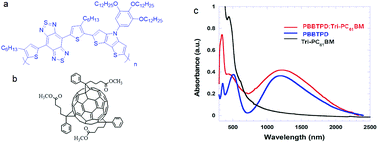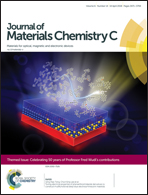Solution-processed broadband polymer photodetectors with a spectral response of up to 2.5 μm by a low bandgap donor–acceptor conjugated copolymer
Abstract
Photodetectors (PDs) with infrared (IR) response have extensive industrial and scientific applications. Broadband polymer PDs that operate at room temperature have drawn the greatest attention in the past years. In this study, solution-processed polymer PDs with a spectral response ranging from 350 nm to 2500 nm are reported. The low bandgap donor–acceptor (D–A) conjugated copolymer contributes to the IR photo-response. Implementation of a bulk heterojunction device structure with polypyrrole as an interfacial layer to match the energy level of the low bandgap D–A conjugated copolymer and the Ba/Al bi-cathode to compress dark current gave rise to a large photocurrent to dark current ratio, which resulted in detectivities greater than 1011 Jones (1 Jones = 1 cm Hz1/2 W−1) at wavelengths ranging from 350 nm to 2500 nm. Thus, our finding of utilization of bulk heterojunction composite consisting of a D–A low bandgap polymer blended with a fullerene derivative provides a facile way to detect IR radiation, indicating that broadband polymer PDs are promising for photoelectronic technology in the future.

- This article is part of the themed collection: Celebrating 50 years of Professor Fred Wudl’s contributions to the field of organic semiconductors


 Please wait while we load your content...
Please wait while we load your content...
